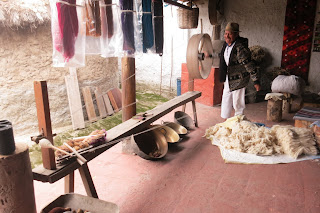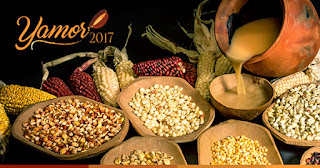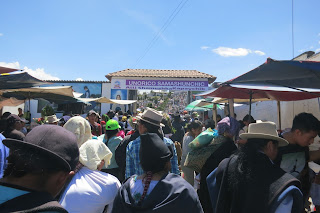Peguche Wasi
When
I went to the English working group with Blady, some of the folks from the US
suggested I visit Peguche
Wasi Gallery/Workshop/Artisan Center, a new museum in Peguche. I tried to visit on
8/22, but by the time I got back from visiting with some of my collaborators, they were
closing. I finally made it to visit last Tuesday. First,
Marina (co-owner) greeted me and gave me a quick tour, but she was in the
middle of cooking lunch, so she didn’t have a lot of time. She then left me
with Jose Conejo, who demonstrated the different weaving techniques out back
and walked around the store with me. Thankfully, he was patient with all of my questions and encouraged me to take lots of photos (like I need to be told twice! I will, however, need to go back when my camera battery is fully charged).
Then, Jose Farinango Lema (the co-owner) showed up, and he went back over some of the information his wife had shared and took the time to talk more with me. He explained that they opened earlier this year, and their mission is to preserve their culture and way of life because they fear Otavalans are losing their history, especially as nearly everyone works with machinated looms now. He said that is why it is important that they also weave and put on demonstrations in their space, rather than just selling items (although some of the people involved also weave textiles at home, which are sold in Peguche Wasi).
The tour starts out front with 4 murals. The space inside is divided into a workshop/display of tapestries and ceramics, from which many of the designs for the tapestries are taken, to the left of the staircase and a store with textiles and handicrafts from all over Ecuador (and Peru) to the right. Up the stairs, there is a living space and dining room. Jose Lema told me they have a few rooms to rent to tourists, like a small hotel. He hoped to recruit me to stay, but accepted that I already live with a family. I promised to help promote the space and suggest it to people I know. Check them out: https://www.facebook.com/Galeria.Museo.Peguche.Wasy/
While the demonstrations were great, the best part for me was learning about many of the designs used in tapestries – a question I’ve had for years! For example, many tapestries feature pre-Colombian renditions of stars, which were important for ancient peoples.
Behind the shop,
there is a covered patio that serves as a restaurant for large tour groups.
Behind that, there is an open patio that is used for parties and get togethers;
on either end, there are wall murals. Continuing back, you encounter a garden
with traditional plants used for healing people and dying thread (on the
right). On the left, there is a partial replica of a traditional round adobe
home with a thatched roof. It houses old ceramic vessels as serves as a display
station for weaving on the Callua waist loom, used to make an old style of
ponchos.
Further back, there is another covered patio, which houses the stations for cleaning, combing, spinning, dying, and reeling wool/yarn, as well as combing finished textiles. It also houses two wooden floor looms: a four pedal loom with thread headles used for an old style of blankets, and a 2 pedal loom with metal headles used for tapestries. There are more tapestries, blankets, and ponchos on display, all of which are for sale.
Then, Jose Farinango Lema (the co-owner) showed up, and he went back over some of the information his wife had shared and took the time to talk more with me. He explained that they opened earlier this year, and their mission is to preserve their culture and way of life because they fear Otavalans are losing their history, especially as nearly everyone works with machinated looms now. He said that is why it is important that they also weave and put on demonstrations in their space, rather than just selling items (although some of the people involved also weave textiles at home, which are sold in Peguche Wasi).
The tour starts out front with 4 murals. The space inside is divided into a workshop/display of tapestries and ceramics, from which many of the designs for the tapestries are taken, to the left of the staircase and a store with textiles and handicrafts from all over Ecuador (and Peru) to the right. Up the stairs, there is a living space and dining room. Jose Lema told me they have a few rooms to rent to tourists, like a small hotel. He hoped to recruit me to stay, but accepted that I already live with a family. I promised to help promote the space and suggest it to people I know. Check them out: https://www.facebook.com/Galeria.Museo.Peguche.Wasy/
While the demonstrations were great, the best part for me was learning about many of the designs used in tapestries – a question I’ve had for years! For example, many tapestries feature pre-Colombian renditions of stars, which were important for ancient peoples.
Further back, there is another covered patio, which houses the stations for cleaning, combing, spinning, dying, and reeling wool/yarn, as well as combing finished textiles. It also houses two wooden floor looms: a four pedal loom with thread headles used for an old style of blankets, and a 2 pedal loom with metal headles used for tapestries. There are more tapestries, blankets, and ponchos on display, all of which are for sale.












Comments
Post a Comment